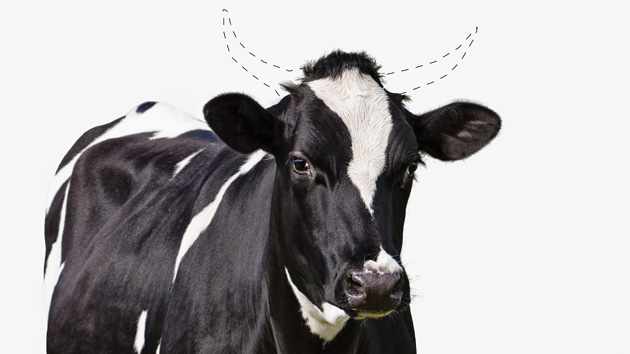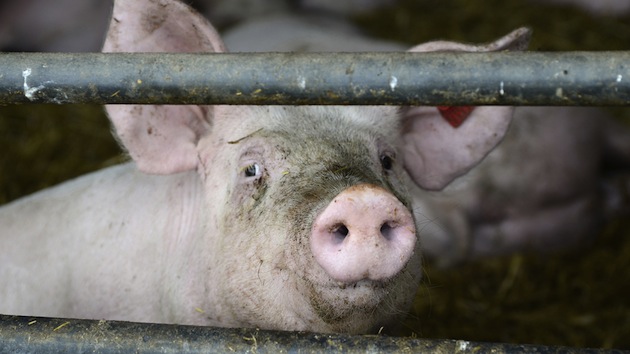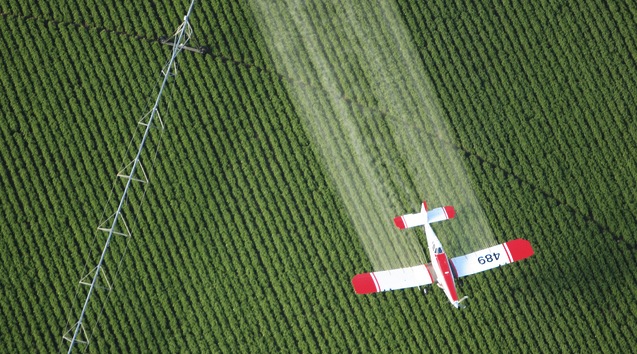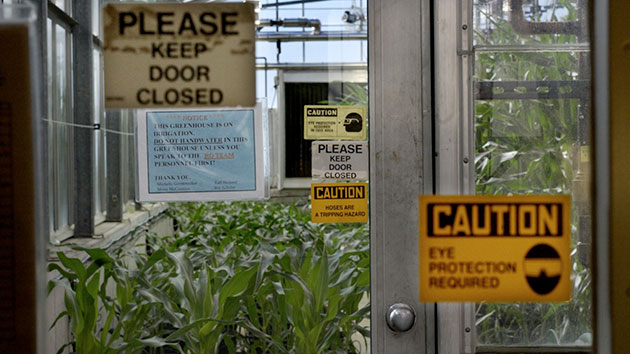
Alloy Photography/Veer; Photoillustration: <em>Mother Jones</em>
Maybe you’ve watched the undercover video: A farmer presses a hot iron into the scalp of a wide-eyed calf, burning away tissue that is beginning to turn into horns. She writhes, moaning pathetically, and collapses in the dirt.
When Scott Fahrenkrug saw that footage, released by Mercy for Animals in 2010, it made him sick to his stomach. Most of the roughly 9 million dairy cows in the United States have been dehorned—with an iron, clippers, or caustic paste—to protect handlers and other cows. Fahrenkrug, then a professor in the department of animal science at the University of Minnesota, decided to do something to stop it. “I started talking to producers, and it became real clear to me that it wasn’t just me being touchy-feely,” he says. Dairy farmers told him they hated dehorning calves, and they were under pressure from animal welfare groups and customers, like General Mills and Nestlé, to phase it out.
Fahrenkrug knew that some breeds of cattle naturally don’t grow horns; the problem is that these “polled” cows traditionally have been lousy milk producers. But in 2012, animal geneticists identified a bit of bovine DNA that controls hornlessness. Fahrenkrug, who specializes in a newly developed genetic modification technique known as precision gene editing, realized it would be a snap to rewrite the corresponding DNA in an embryo of a dairy breed. Presto: Hornless cows that give a lot of milk. So he quit his steady academic job and devoted himself full time to Recombinetics, the biotech startup he’d founded several years earlier.
Fahrenkrug thinks hornless milk cows are just the start. Recombinetics is tweaking the DNA of a few high-performance cattle breeds so they are more heat tolerant and can thrive in a warming world. He has developed piglets that are resistant to common diseases, and has plans for meatier goats to feed a growing global population. Fahrenkrug’s ultimate goal is animals with just the right mix of traits—and much less suffering.
Theoretically, these alterations are pretty straightforward. But Fahrenkrug still must contend with federal regulators who have never approved a genetically modified food animal. His biggest challenge, though, will be to change the minds of the public. Many people see GM foods as a symbol of all that’s wrong with the industrial food system. Fahrenkrug will have to convince them that it offers the surest and fastest route to more ethical and sustainable farming.
Recombinetics is a far cry from Big Ag: It consists of about 20 people in a former state forensics lab in St. Paul, Minnesota, with about $11 million in equity investments, according to Fahrenkrug. The company has three divisions, two of which focus on biomedical applications for gene editing, like making animal models of human diseases. Although his title at the company is CEO and chairman of the board, Fahrenkrug has always been a scientist, whether as student, an academic, or a government researcher, and he still tends to draw graphs when explaining anything complex. He still looks the part: a middle-aged guy with a goatee and hipster glasses. His first experience of the business and biological realities of farming wasn’t until graduate school, when he visited a fellow student’s family’s Minnesota cattle ranch. It was calving season, and one of the Red Angus cows was struggling with obstructed labor, a common problem in that breed. Fahrenkrug was enlisted to help her deliver. The calf and cow survived, but it was a bloody mess, he says. The problem was that the calves with the big muscles that are prized for beef also tend to cause problems during birth. It was a breeding conundrum—the good trait came along with the bad one, and breeders couldn’t separate the two. But maybe genetic engineering could.
Many GM crops are now on the market, yet no GM meat animal has ever made it that far. Scientists at the University of Guelph in Ontario at one point created the Enviropig, a transgenic hog with a mouse gene that produced less water-fouling phosphate in its manure. That project ran out of funding and backers while awaiting regulatory approval, and the last Enviropigs were slaughtered in 2012. A fast-growing transgenic salmon, which has a gene from another fish called an ocean pout, has been in the regulatory process in one form or another for 20 years, and it is not popular. A preliminary FDA assessment in 2012 attracted 38,000 public comments, mostly of the “vehemently opposed” variety.
The reason Fahrenkrug thinks his polled cows will be different is because the technology he’s using is new. While many older genetically engineered organisms contain genes from a different species—like the tomato with a fish gene spliced in—the new technology does not require the use of foreign DNA, and he at first plans to use only variations that already occur in the species. His hornless Holsteins are all cow, the pigs are all pig. What’s more, gene editing is extremely precise. As the name suggests, it’s a little like a word-processing program: Just as a skillful editor can delete or add a word to improve a sentence without interfering with the structure of a document, gene editing makes it possible to change or disable a single gene without changing the “meaning” of the rest of the genome. So undesired effects such as accidentally turning off a useful gene or creating a new toxic or allergenic protein seem to be less likely than with previous GM techniques.
When I toured the office, Fahrenkrug grabbed a photo off the wall of two winsome, knobby-kneed black-and-white calves. Where a typical Holstein calf would have little horn buds, they have no horns, or scars, or swirls of hair where horns used to be. He doesn’t want to disclose where the calves are living since he’s concerned about anti-GMO activists. But soon, he says, they will be offered as sires for artificial insemination, the breeding method used by most US dairy farmers. Because polled is a dominant gene, their offspring will inherit the hornless trait, and will pass it down to their descendants as well.
Because hornlessness is a naturally occurring gene variant, it cannot be patented; Recombinetics’ intellectual property claim rests on the unique combination of that polled DNA variation on that Holstein background. In this case, the price will likely be set according to a complex calculation of the novelty of the combination of traits; in the short term, since high-performance polled Holsteins are rare, Recombinetics plans to charge a higher price that depreciates as the breed transitions to hornlessness. It’s not so different from any other animal breeder pricing their blue-ribbon genetics.
Fahrenkrug says he doesn’t expect to make much money off of the polled cows—they’re more of a test case. He thinks the best market potential will come through adding natural traits that improve sustainability, such as helping animals resist diseases or grow faster without antibiotics (animals today are often fed antibiotics even when they’re healthy, because the drugs accelerate weight gain). One beast waiting in the wings may begin to deliver on that market potential.
In a barn about 40 miles outside of Minneapolis, along a country road lined with corn and soybean fields and dotted with grain elevators, live a few very special pigs. They don’t look any different from the 300-odd ordinary sows that live together in this breeding barn. All are the same pinkish color, and as Recombinetics chief marketing officer Mark Walton and I walk past, they size us up with their inquisitive little piggy eyes in the usual way. Just like any pigs, they grunt expectantly and snuffle your pants legs if you let them, and if you scratch their sides hard, they squeal in pleasure.
But two of the sows here harbor secrets. Unlike their barnmates, their piglets will not be raised for meat; instead they will become key players in the Recombinetics scheme to avoid castration via gene editing. Because the meat of sexually mature male pigs can develop a funky locker-room smell called boar taint, male piglets raised for pork routinely have their testicles removed to prevent puberty. Like dehorning, it’s a painful procedure that costs farmers money. Soon, farmers in some countries will be required to provide pain-killers to their pigs, upping the expense and complexity of castration. But there also could be a genetic solution.
Here’s how it works: In another Recombinetics barn in Wisconsin live a different group of male pigs that are missing a gene called KISSR, which controls sexual development hormones. As they grow up, their testicles will never enlarge and descend and they will never develop that unmistakable ripe smell of an adult boar. As commercial animals, they would save farmers the cost of castration, and they would maintain the superior “feed conversion rate” of prepubertal animals—meaning that they get fatter more quickly on less food.
But because they won’t develop mature testicles, they also will never be able to pass on their genes. That’s where these sows that I’m meeting come in. Their male piglets have a tiny bit of added DNA that disables a gene called DAZL and prevents them from ever producing any of their own sperm. Other than being sterile, all their other reproductive equipment will function just fine; their job is to act as sperm incubators for the sexually underdeveloped KISSR animals. Producing the next generation of prepubertal pigs will involve transplanting cells from their undescended testicles into the spermless DAZL pigs, which then produce KISSR sperm. That, ultimately, is the product Recombinetics would sell for use in artificial insemination, and Fahrenkrug calculates that the $23.4 billion US pig farming business could stand to gain $1 billion by switching to pigs that don’t need to be castrated. As a side benefit, there’s no way that either gene modification could escape the barn and spread to other animals, since neither animal can reproduce on its own.
Right now, the pigs are just protoypes; whether the company invests in making them commercially viable depends on demand, business projections, and what the world thinks about genetically modified polled Holsteins.
It’s possible that the Recombinetics animals will wind up in regulatory purgatory, just like the transgenic salmon. An FDA spokeswoman says that while the agency is still in “the deliberative process” regarding the newer precision gene editing techniques that Recombinetics is using, its regulatory authority covers “animals that have been engineered (in any way),” even if the altered trait also occurs in nature.
But it’s also conceivable that they will get a pass. In a parallel case, the FDA recently ruled that new potato and apple varieties modified without foreign genes are “as safe as their conventional counterparts.”
In the meantime, Fahrenkrug, who is known among his animal-scientist peers for his determination, says he’s not planning to seek the FDA’s approval under current regulations for animal genetic engineering for the polled cow project. Those rules shouldn’t apply, he says, because it doesn’t create any features that don’t already occur: Farmers can already breed hornless dairy cows.
Fahrenkrug thinks that organic farmers have the most to gain from his technology, because it offers a path to healthy, high-producing animals without using hormones or antibiotics. They may not agree. Guy Jodarski, the supervising veterinarian for Organic Valley, a cooperative of more than 1,700 organic dairy farmers, points out that beyond the FDA, the use of gene editing would also need to pass muster under the US Department of Agriculture’s Organic Standards and by the cooperative’s members.
Still, there’s little doubt that many dairy farmers are interested in converting over to polled genetics. Until recently, there were very few high-quality polled dairy bulls, because breeding them that way is so slow and expensive. That is beginning to change. In fact, Fahrenkrug’s biggest problem may turn out to be not regulators, skeptical consumers or anti-GMO activists, but a conventionally bred, two-year-old black-and-white hornless Holstein bull by the name of View-Home Powerball. The Holstein breed association formula predicts that Powerball, bred for first-class dairy genetics, will soon rank among the nation’s top five breeding bulls, as measured by the health and productivity of his many hornless daughters. For just $1,000, dairy farmers can buy 10 straws of Powerball’s semen, enough to breed dozens of cows.
Fahrenkrug is not daunted by the competition. “One bull ain’t good enough,” he insists. Dairy producers can’t build their herds on a single animal without getting into trouble with inbreeding. Recombinetics, in contrast, could edit the polled gene variant in dozens or hundreds of genetically diverse bulls. And that would be just the beginning: With this technology, it will be able to incorporate valuable traits from obscure breeds all around the world, developing new breeds that are hardy and healthy without the slow, unpredictable work of crossbreeding.
Fahrenkrug is confident that even the people who don’t currently like the idea of genetic modification will come around once they see the benefits. It’s not that he expects people to change their minds about GM corn or Monsanto. He just wants them to see that this time, the equation is different. “I’m not ignoring the challenges, but I think the moral argument surpasses the challenges,” he says. “It’s going to happen.”
















